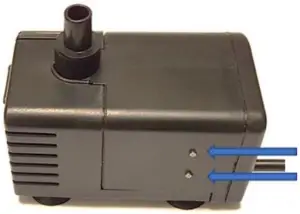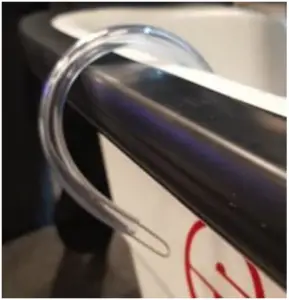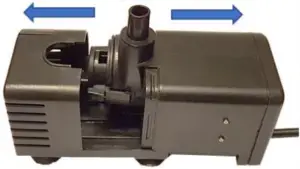GLB Nordica SL-35 User Manual
General
SL-35 is designed to drain rainwater from an open boat. The bilge pump is powered entirely from the sun and requires no maintenance. The radiation from the sun is converted in the solar panel to electricity that drives the pump. Suitable placement of the panel is on the stern or in the engine well. Mounting bracket for the motor well is available as an accessory.
It is extremely important that the panel is mounted in the boat so that the entire panel is sunlit without being shaded. If parts of the panel are in the shade, electricity production from the entire panel is stopped.
When choosing the location of the solar panel, it is important to keep in mind where the south is when the boat is moored and that the panel is not shaded when the sun is low. At our latitudes in the summer when the sun is up more than half a day, it is best to place the panel horizontally. In this way, the pump can work from early morning until late evening.
If you want to use the boat late in the autumn, you can in the autumn angle up the panel to the south for more solar energy.
The solar radiation is approx. 1 kW per m2 and the solar cell converts approx. 20% of the solar energy to electricity. When the angle of the sun to the panel is small, the power decreases and the production of electricity decreases. At sunrise, the pump starts when the sun’s angle to the panel is greater than 20 degrees.
User manual SL-35
SL-35 consists of 3 main components.
The solar panel measuring 27 x 16 x 2 cm is conveniently placed on the stern and fastened with Velcro that sits in the corner of the panel. Clean the intended mounting location with acetone for secure attachment. Press the supplied brackets onto the panel brackets, remove the protective tape and press the panel where it should sit.
It takes 3 days for the self-adhesive bracket to harden.
If the surface is not clean or smooth enough, you may need to glue the brackets with Sikaflex or similar.
On the back there is a plug to which the pump’s cord and plug are connected. The connector is sealed but we recommend that the connector is under the panel in protection from rain. If the panel and the pump are mounted further apart so that the cord is not enough, there is an extension cord of 5 meters to buy from us.
The bilge pump is conveniently placed in the stern and there is often a depression in the bottom of the boat which means that the boat is almost completely emptied of water.
The kit includes cable ties and cable tie anchors. Glue 2 cable tie anchors to the bottom of the boat and fasten the pump with a cable tie.
Keep a distance between the brackets so that the pump fits in between and comes as close to the bottom as possible.
The cord is pulled to the panel and cable ties can be used to get a nice pull of the cord and hose.
If the pump is placed with a risk of damage, there is a pump cover in stainless steel as an accessory.
The cord is 1.5 m and what is left over can be bundled together with a cable tie and lie under the panel. In this boat you could pull the cord inside the storage compartment.
The cable tie anchors are provided with self-adhesive glue, which glues well except on a rough surface. We then recommend that they are glued with Sikaflex or similar, do not forget to wash the surface with acetone, alcohol or similar.
The pump is equipped with 2 pins on the side where the electronics in the pump measure the resistance between the pins and turn off the pump if the water surface is lower than the upper pin. The pump therefore needs to be placed with the outlet straight up.
Because the pump is switched off when the boat is empty, there is no dry running of the pump with a very long service life as a result. When the pump is switched off, the water level at the pump is approx. 20 – 25 mm.
The hose is 1.5 m long and is normally drawn from the pump to the motor well or when it is not over the railing.
The kit has a steel wire that is inserted into the hose end, which means that you can easily bend the hose and place it in a soft arc over the railing.
Make sure that there is no crease which would drastically reduce the flow. The hose can also be fastened in a nice way with the help of the included cable tie anchors and cable ties.. This is what the installation can look like when it is finished. As the cord between the pump and the panel in this boat could be pulled in the storage space, only the hose that was pulled was visible. The hose is conveniently placed in the engine well when present.

The flow is affected by the height difference between the hose end and the bottom of the boat. If the railing is high, the hose end can be stuck down a bit to reduce the lifting height. It is suitable that the hose ends approx. 30 cm from the water surface.
Maintenance. The pump is very robust and the strainer function that exists in the form of slots in the pump housing effectively prevents leaves and gravel from entering the pump at the same time as leaves have difficulty clogging the strainer on the outside. If for some reason the pump has stopped, it is easy to check that there is nothing in the pump housing.
The easiest way is to blow into the hose or the outlet on the pump.

If this does not work, you can open the pump by pulling the cover apart. Then turn the pump cartridge 1 cm clockwise, after which the entire pump shaft and rotor can be pulled out. Be careful not to break the pump shaft.
You can now easily inspect that there is nothing stuck in the pump blades.
The pump is assembled in a corresponding way by pushing back the pump shaft and turning 1 cm counterclockwise. Then replace the pump housing.
Winter storage The pump must be empty of water as icing in the pump expands and the plastic may crack. Make sure there is no water or take in the pump in the winter. The panel can also be stored indoors, even if it can overwinter outside.
Important to remember
The solar panel must be mounted so that it does not end up in the shade.
The solar cells are connected in series and if any cell is in shadow, the entire panel’s power production is throttled. (Same principle as when a fold on the garden hose stops the entire water flow).
If the solar panel is placed on the deck or engine well, it should preferably be directed between southwest and southeast when the boat is moored.
The pump must be protected from icing inside.
Algae formation in the water can give a coating on the pump so that the pump continues to run even though the water level is below the upper pin. You then need to clean the pump between the pins.
If the pump is exposed to a lot of contaminants, you can make a bag of mosquito nets or similar that the pump can be placed in.
References
[xyz-ips snippet=”download-snippet”]
